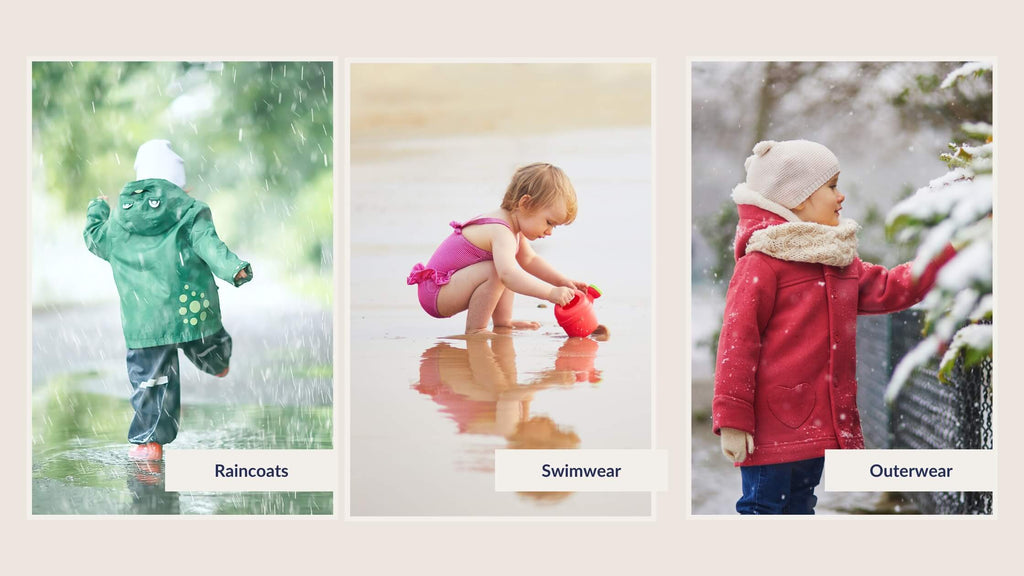Are you locked in a daily battle trying to get your child with eczema dressed? The culprit might not be your child's resistance; it could very well be their clothing! Have you taken a closer look at those clothing labels lately? Could it be the polyester blends? Is polyester bad for eczema? Believe it or not, the fabrics in your child's clothes, especially synthetic ones like polyester, can irritate kids struggling with eczema. Stick around to uncover the intriguing connection between your child's wardrobe and those eczema flare-ups. We're here to tell you that better mornings, and happier skin, are within reach with the right choice of fabrics.
What is Polyester?
Polyester is one of the most common fabrics in clothing today. The fabric was introduced in the 1950s and has been popular ever since because it’s resistant to wrinkles and shrinking, easy to care for, and can be made into many styles of clothing. So what exactly is polyester you ask? Polyester is derived from petroleum. That’s right! Polyester is a synthetic material that comes from oil and closely resembles plastic. It is made through polymerization, which is a chemical reaction occurring among petroleum, air, and water. Today more than 60% of clothing contains polyester and other synthetic fibers.
What is Made of Polyester?
Polyester is a versatile fabric used in various types of clothing. It's commonly found in everyday items like t-shirts, sweatpants, and formal attire, including dresses and blouses. Polyester's durability and wrinkle resistance make it popular for outerwear like jackets and raincoats. You'll often encounter polyester in activewear, from moisture-wicking workout shirts to leggings. Swimwear and undergarments also utilize polyester for its smooth feel and stretch. Beyond clothing, polyester appears in accessories, hosiery, and even home textiles like bedding and curtains.

What are the Advantages of Polyester Clothing?
If polyester is made from oil and as you will soon find out - is bad for your skin - why is polyester so popular? Some advantages of polyester are listed below:
Durability
Polyester is highly resistant to wear and tear. It maintains its shape and color even after repeated washing and use.
Wrinkle Resistance
Polyester is wrinkle-resistant, which means garments made from this fabric stay relatively neat, reducing the need for ironing.
Quick Drying
Because polyester doesn't absorb moisture, it dries quickly, making it suitable for swimwear and outdoor gear.
Color Retention
Polyester holds dye (note: many of the dyes are considered toxic) exceptionally well, resulting in vibrant and long-lasting colors.
Affordability
Polyester is cheaper than cotton because it can be mass produced.
While polyester still remains a poor choice for kids with eczema, recycled polyester is a great choice for some clothing items including outerwear and swimwear.
Is Polyester Bad for Skin?
Absolutely! Synthetic fabrics like polyester can be harmful to skin health, particularly for those with eczema or sensitive skin. Here's why: Firstly, polyester, essentially a form of plastic, lacks breathability. It traps moisture against the skin rather than allowing it to evaporate, leading to irritation. Moreover, the production of polyester involves perfluorochemicals (PFCs), which are known to have adverse effects on various aspects of health, including growth, sexual function, and liver function. Some PFCs are even recognized as carcinogens, posing cancer risks. For individuals with eczema or sensitive skin, polyester can be especially problematic.
Can Polyester Cause Eczema?
Polyester itself is not a direct cause of eczema. Eczema, also known as atopic dermatitis, is a chronic skin condition characterized by inflammation, itching, and sometimes rash-like symptoms. A mix of genetic, environmental, and immune system factors are related to eczema. However, some individuals with eczema may find that wearing clothing made from certain synthetic fabrics, including polyester, can exacerbate their symptoms or trigger flare-ups. This doesn't mean polyester causes eczema but instead that it may contribute to skin irritation in some people with sensitive skin.

Does Polyester Irritate Eczema?
One of the key concerns with polyester for eczema sufferers is its tendency to retain moisture. The fabric's hydrophobic nature means it doesn't absorb moisture well, and sweat can accumulate on the skin's surface. This moisture retention can disrupt the skin's natural barrier and create a perfect breeding ground for bacteria, which can exacerbate eczema symptoms. Moreover, the lack of breathability can make it challenging for the skin to regulate its temperature, increasing the risk of overheating and itchiness.
Can You Develop a Polyester Allergy?
Polyester fabrics contain residual chemicals from the manufacturing process. These chemicals, such as dyes and finishing agents, have allergenic properties that can irritate sensitive skin. Many individuals with sensitive skin and/or eczema have reported skin reactions, including redness, itching, and a rash, when wearing polyester clothing. While not everyone will experience these issues, it's essential to be aware of the potential allergenic properties of polyester.
Is Polyester Itchy?
Perhaps the most common concern with polyester for eczema-prone individuals is the potential for skin irritation and itching. The synthetic fibers in polyester can feel rougher against the skin compared to natural fibers, which can lead to discomfort and itching, especially if the fabric rubs against sensitive areas. Additionally, the lack of breathability and moisture management can exacerbate itching, making it difficult for individuals with eczema to find relief when wearing polyester.
Is Polyester Breathable?
One of the key concerns with polyester for eczema sufferers is its tendency to retain moisture. The fabric's hydrophobic nature means it doesn't absorb moisture well, and sweat can accumulate on the skin's surface. This moisture retention can disrupt the skin's natural barrier and create a perfect breeding ground for bacteria, exacerbating eczema symptoms. Moreover, the lack of breathability can make it challenging for the skin to regulate its temperature, increasing the risk of overheating and itchiness.
Is Polyester Toxic?
Polyester itself is not inherently toxic when used in its finished fabric form. It's a synthetic polymer made from petroleum-based materials. However, concerns related to potential toxicity are more often associated with the production process and certain additives or treatments used with polyester. Additionally, some additives or finishes applied to polyester textiles, such as flame retardants or stain repellents, can contain toxic substances. Consumers can follow care instructions to minimize potential risks and be aware of any added treatments or finishes on their polyester garments.
Though it may feel soft to the touch, polyester and polyester blends are bad for kids with eczema.
What are Some Alternatives to Polyester for Eczema-Prone Skin?
The best alternatives to polyester are fabrics made from natural fibers. Top alternative options include:
Organic Cotton
Look for 100% organic cotton, preferably GOTS certified organic cotton. Cotton is naturally soft and great at absorbing moisture. It is often blended with other fabrics (including polyester), so be sure to read the label on clothing marketed as “cotton” to ensure it is truly 100% cotton before you purchase it for kids.

TENCEL™ Lyocell
TENCEL™ Lyocell is derived from Eucalyptus trees and uses a closed loop process to recycle chemicals used during production. Beyond being another breathable and incredibly soft material, TENCEL™ Lyocell is more eco-friendly than bamboo and naturally hypoallergenic.
TENCEL™ Modal
TENCEL™ Modal is similar to TENCEL™ Lyocell, but made from Beechwood trees instead of Eucalyptus. It is also super soft and comfy with an almost buttery feel to the touch. Its durability makes TENCEL™ Modal great for essential garments base layers and underwear.

Silk
Silk is among the softest natural fibers and is an incredible insulator, which makes it wonderful for cold environments. It may be more difficult to wash as compared to cotton, but “easy care” washable versions are available.
Bamboo
Bamboo is often cited as a great fabric for kids with eczema. It is super soft, breathable, and plentiful. The drawback of bamboo is that it is processed using harmful chemicals. While bamboo is certainly a better option than polyester, organic cotton, TENCEL™ Lyocell, and TENCEL™ Modal are superior because of the methods to produce the fabric.
What are Some Tips for Choosing Eczema-Friendly Clothing?
Read Clothing Labels
First and foremost, take a close look at the labels and look for natural fiber clothing. Understanding what your clothes are made of is essential. Natural fibers like cotton, silk, and modal tend to be gentler on sensitive skin. Avoid polyester, spandex, acrylic, and nylon.
Choose Loose-Fitting Clothing
Choose loose-fitting clothing that doesn't rub or chafe against the skin. Tight garments can cause friction and exacerbate eczema.
Avoid Rough Textures
Be mindful of clothing with rough or scratchy textures, as they can aggravate sensitive skin. Look for fabrics with a soft, smooth finish.

It's important to note that individual reactions to clothing materials can vary widely. Some people with eczema may find that polyester garments do not irritate their skin, while others may need to avoid synthetic fabrics altogether. If you or your child has eczema, it's a good idea to choose clothing made from natural fibers like cotton, silk, or bamboo, which are generally less likely to cause skin irritation. Additionally, washing new clothing items before wearing them can help remove any potential irritants or residues from the manufacturing process. If eczema symptoms persist or worsen, it's advisable to consult a dermatologist for proper diagnosis and management.




